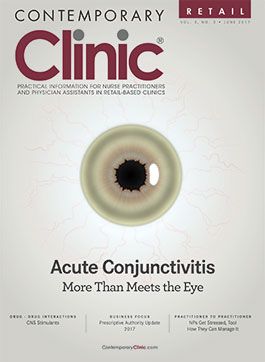Acute Conjunctivitis: More Than Meets the Eye
Acute conjunctivitis, or “pink eye,†is inflammation of the conjunctiva, the clear thin mucous membrane lining the inner eyelids and covering the sclerae.
Acute conjunctivitis, or “pink eye,” is inflammation of the conjunctiva, the clear thin mucous membrane lining the inner eyelids and covering the sclerae. It typically presents in the primary or urgent care setting as a red eye with discharge. The most common infectious etiologies of acute conjunctivitis include viruses, particularly adenovirus, and bacteria, commonlyStaphylococcus aureus, Streptococcus pneumoniae, Moraxella catarrhalis,andHaemophilus influenzae. Neisseria gonorrhea can cause hyperacute conjunctivitis; gonococcal infections are transmitted from the genitalia to the hands to the eyes and cause sudden onset of severe red eye with profuse purulent discharge.
Noninfectious conjunctivitis usually results from allergies and can be seasonal, caused by certain outdoor pollens, or perennial, caused by molds, animal dander, or dust mites. Allergic conjunctivitis may be accompanied by classic hay fever symptomatology (eg, itchy eyes, sneezing, nasal congestion, postnasal discharge, and clear rhinorrhea).1
CASE STUDY
A 6-year-old, generally healthy female is brought to your primary care office by her mother complaining that she woke up this morning with her right eye stuck shut; the eye feels scratchy, is a pinkish red color, and has a whitish yellow discharge in the inner corner. The patient denies ocular pain, visual changes, photophobia, trauma, and contact lens use. She reports a 1- to 2-day history of dry cough and mild sore throat, stuffy nose, and low-grade fever with a maximum temperature of 99.8°F taken orally, but no high fever, rash, nausea, vomiting, diarrhea, or abdominal pain. She also has no joint pain or swelling, has not recently traveled or gotten a new pet, and is not aware of any sick contacts, although she is in kindergarten. She has no history of allergies, hay fever, asthma, or atopic dermatitis and has had no contact with chemicals.
Physical examination reveals a temperature of 99.9°F. Her right eye, left eye, and bilateral visual acuity are all 20/20. Her pupils are equally round and reactive to light; extraocular movements are intact. There are no lid lesions or periorbital edema or erythema. The right eye is positive for diffuse conjunctival injection and erythema, with stringy watery mucoid discharge; the left eye conjunctiva is clear, with no discharge. There is nasal congestion and edematous turbinates with a whitish yellow nasal discharge and mild erythema and edema of the posterior pharynx, without exudates. Her skin is clear without rashes, and her lungs are clear to auscultation bilaterally, with full and equal vesicular breath sounds.
DISCUSSION QUESTION: What is your initial diagnosis for this patient?
ANSWER: Based on the history and physical findings of acute conjunctival injection with watery mucopurulent discharge, low-grade fever, and upper respiratory infection (URI), her diagnosis is acute infectious conjunctivitis, most likely caused by adenovirus. Viral conjunctivitis classically presents with acute conjunctival infection; a watery, mucoid discharge; and a gritty sensation in 1 eye, which usually affects the second eye within 1 to 2 days. There may or may not be associated sore throat, fever, and URI symptoms. Bacterial conjunctivitis classically presents with unilateral conjunctiva injection; the affected eye may be stuck shut in the morning, with a thick purulent discharge that gets worse after wiping eyelids.2Allergic conjunctivitis typically presents with bilateral eye itching, diffuse redness, and watery discharge in a patient with a history of allergies or hay fever.
DISCUSSION QUESTION: What are the treatment options for acute conjunctivitis?
ANSWER: The online table3illustrates treatment options for acute conjunctivitis. General patient education includes thorough and regular handwashing with soap and water and avoiding contact with personal items from infected individuals. Patients can generally return to school or work after 24 hours of antibiotic drops.
DISCUSSION QUESTION: What questions are important to ask to rule out more serious differential diagnoses?
ANSWER: Certain causes of an acute red eye prompt urgent evaluation by an ophthalmologist. Sudden reduction in visual acuity may be caused by glaucoma, keratitis, or iritis; photophobia can indicate keratitis or iritis; severe pain or severe foreign body sensation may be infectious keratitis; severe headache, malaise, and nausea with a red eye suggest acute glaucoma. Physical findings that indicate more serious causes of an acute red eye include reduction in visual acuity, fixed or irregular pupils, corneal opacities, and ciliary flush. Patients with contact lenses may be at risk for serious infections, including keratitis, and should discontinue contact lens use and see an ophthalmologist if symptoms persist after 12 to 24 hours.
SUMMARY
Acute conjunctivitis is a common, self-limited, and generally benign eye condition that commonly presents in the primary and urgent care settings. A thorough history and physical examination can generally reliably diagnose acute conjunctivitis and determine its etiology to guide treatment. Serious diagnoses, such as keratitis, iritis, eye trauma, and glaucoma should be considered and immediately referred to an eye specialist if suspected.
Jennifer Hofmann Ribowsky, MS, PA-C, is is a physician assistant with several years of clinical experience in primary care outpatient medicine and a master’s degree in clinical pharmacology. Her current academic position is clinical associate professor in the Pace University Lenox Hill Hospital PA Program and primary course instructor for medical pharmacology courses.

